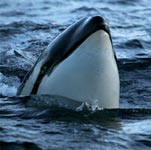
|
|
| |
Listed in genres:
· Soundscapes, Field Recordings
|
|
Notes:
|
Field Recordings
Recorded with Reson TC4032 Hydrophone, 20 m cable and custom built ETEC amplifier on either Edirol or Korg MR1000 recorder.
Tracklist:
01. Carousel feeding Killer whales (7:38)
Location: Tysfjord (2005)
Killer whales (Orcinus orca) feed on herring using a method called carousel feeding: The whales herd the herring tightly together and chase it close to the surface, where they hit it with their tails to kill or stun it. Then they eat the herring one by one. You hear many clicks, which the whales use for echolocation to find the herring. Buzzes, calls and whistles are used for communication, and in addition you hear tail slaps that kill the herring.
02. Calling Pilot whales (8:33)
Location: Vestfjord, outside Skrova (2006)
A group of long-finned pilot whales (Globicephala melas) came close to our boat and you can hear one male calling, and in the distance another whale answering. The male was the first that came 10m close to our boat and he just lay there looking at us, calling. Then the rest of the group also came close to investigate us. Pilot whales are deep divers and feed mostly on squid. Not much is known about their vocal behaviour, but they are often very curious and you can find them travelling in large groups.
03. Atlantic white-striped dolphin group (6:48)
Location: Vestfjord, just outside Henningsvaer (2008)
A group of 30-40 Atlantic white-sided dolphins (Lagenorynchus acutus) appeared just in front of our boat. These dolphins were very curious, swimming behind and under our boat. Audible are many echolocation clicks, as well as some buzzes and whistles.
04. Post-feeding calls of Killer whales (0:31)
Location: Tysfjord (2005)
These calls were recorded from killer whales after they feasted on herring. Their calls are used for communication with each other.
05. Echolocating male sperm whale (3:25)
Location: Vesteralen outside Andenes (2006)
Male sperm whales (Physeter macrocephalus) migrate from the south to the north to find food. They use echolocation to find squid or fish in depths up to 2000m. You hear clicks from a male sperm whale recorded outside Andenes.
06. Harbour seal pup calling for its mother (1:20)
Location: Vesteralen outside Stø (2006)
Harbour seals (Phoca vitulina) live close to the coast in colonies of up to several hundred animals. They have their young in June. Outside Stø on Vesteralen there is a colony of harbour seals, where we recorded a pup calling for its mother.
07. Basking shark and Mackerels feeding on plankton (1:08)
Location: Vestfjord, just outside Henningsvaer (2007)
One basking shark (Cetorhinus maximus) and a group of mackerel (Scomber scombrus) were feeding on plankton in summer 2007 just under the bridge of Henningsvaer. Basking sharks are filter feeders and come to the northern waters in summer to feed on plankton. You can hear feeding sounds and some chirps, which probably come from the mackerel. It is not known whether basking sharks or mackerel communicate with sounds.
08. Acrobatic Atlantic white-striped dolphins (3:46)
Location: Vestfjord, south of Henningsvaer (2008)
On a summer evening we met 4 Atlantic white-sided dolphins (Lagenorynchus acutus) in the middle of the Vestfjord. First they investigated us and then they started an amazing acrobatic show, jumping out of the water for more than 30 minutes, producing clicks, buzzes and some “croaks”.
09. Pilot whales resting in Vestfjord (9:37)
Location: Vestfjord, outside Skrova (2008)
Pilot whales appear year-round in the Vestfjord . We do not know where they come from, and we always see different animals. This recording was from a resting and slow-travelling group that came close to the boat several times, producing a variety of different calls, buzzes and clicks.
10. Seine feeding killer whales (6:17)
Location: Vestfjord, close to Lødingen (2005)
One winter day in 2005 a herring net broke from a seiner. It took less than 30 minutes for more than 60 killer whales to arrive, turning into a feeding frenzy. The sounds are killer whales calling, whistling and echolocating. In the background you can hear the engine of the fishing boat with the broken net. Killer whales have long learned that they get “free” food from herring fishing boats, often lingering around these boats.
11. Carousel feeding killer whales (5:45)
Location: Tysfjord (2005)
When killer whales feed on herring, they use different calls for communication. Sound underwater is louder and travels much faster than in air. When we produce noise with motorized boats, we pollute the whales’ environment and make it difficult for them to communicate. This may interrupt their feeding and social behaviour. We must continue to be vigilant, always consider our reasons for approaching whales, and most important of all: HOW.
You hear a big whale-watching boat idling, then starting and stopping the engine. Later, you hear a small whale-watching rubberboat starting its engine.
|
| |
|